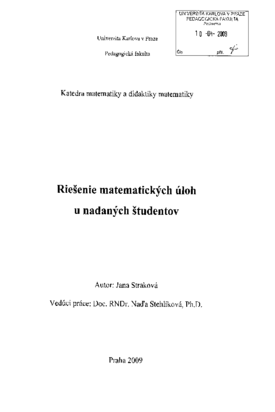Riešenie matematických úloh u nadaných študentov
Mathematics Problem Solving of Gifted Students
Řešení matematických úloh u nadaných studentů
diplomová práce (OBHÁJENO)

Zobrazit/
Trvalý odkaz
http://hdl.handle.net/20.500.11956/22830Identifikátory
SIS: 74060
Kolekce
- Kvalifikační práce [19358]
Autor
Vedoucí práce
Oponent práce
Novotná, Jarmila
Fakulta / součást
Pedagogická fakulta
Obor
Učitelství všeobecně vzdělávacích předmětů pro základní školy a střední školy anglický jazyk - matematika
Katedra / ústav / klinika
Katedra matematiky a didaktiky matematiky
Datum obhajoby
1. 6. 2009
Nakladatel
Univerzita Karlova, Pedagogická fakultaJazyk
Slovenština
Známka
Výborně
Diplomová práca sa zaoberá spôsobmi myslenia a konania nadaných študentov z Českej a Slovenskej republiky pri riešení aplikačných slovných úloh. Popri identifikácii a kategorizácii stratégií riešení zadaných matematických úloh sa pomocou hĺbkovej analýzy písomných prác nadaných študentov pokúšam o preniknutie do myslenia a uvažovania študentov pri riešení úloh. Zameriavam sa na využitie študentských matematických vedomostí a zručností na riešenie problémov z reálneho sveta, na mieru aplikácie automatických matematických postupov, prácu s chybou a neúspešnou stratégiou, študentské uchopenie úlohy a študentský prejav. Dáta zozbierané pomocou zadanej písomnej práce a dotazníka, metódami hĺbkových rozhovorov a pozorovaní sú analyzované pomocou zakotvenej teórie a následne konfrontované s výsledkami medzinárodných štúdií realizovaných v podobnej oblasti matematiky.
The thesis focuses on the ways of thinking and acting of students from the Czech and the Slovak Republic, while solving application problems. On the one hand the thesis offers the identification and categorisation of solving strategies of mathematical problems by gifted students. On the other hand, there is an attempt for the insight into students' thinking processes by means of an in-depth analysis of their written work. I focus on the utilisation of students' mathematical knowledge when solving real-life problems, on the extent to which they apply automatic mathematical methods, on students' reactions to mistakes and unsuccessful solving strategies, their grasping of tasks and their discourse. The data is collected by means of students' written solutions to two mathematical problems, a questionnaire, semi-structured interviews with teachers and observations of their lessons. The data has been analysed through grounded theory and the results are compared with particular results of international comparative researches (PISA and TIMSS).
